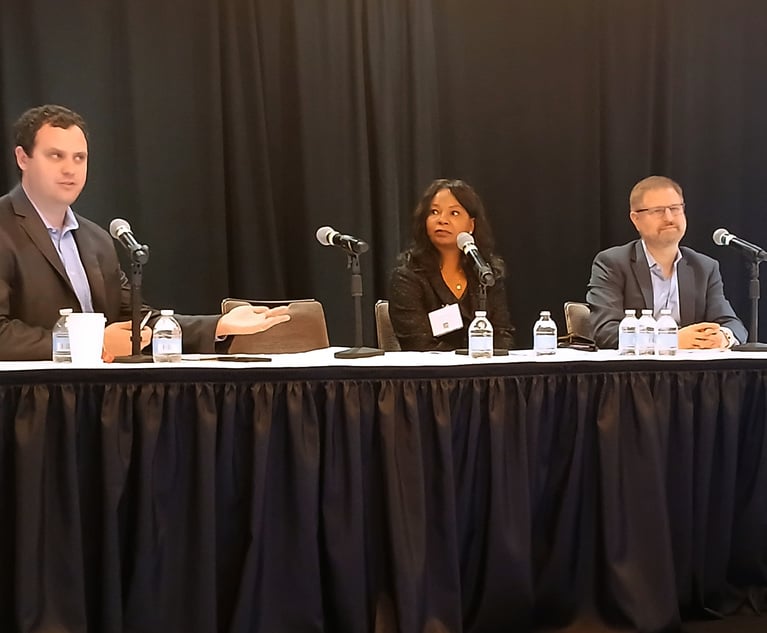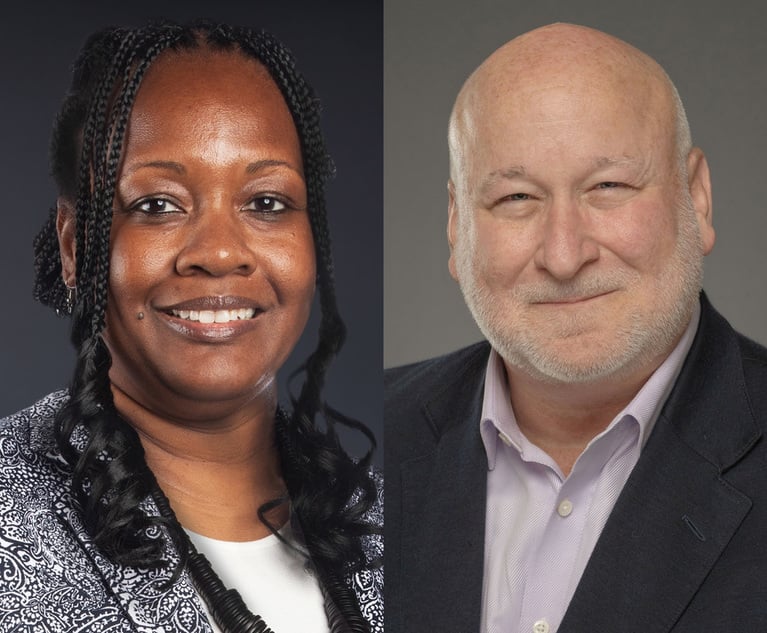Helping in-house and outside counsel work better together
Two key strategies to bring the two sides closer and avoid mistakes.
June 30, 2011 at 08:00 PM
4 minute read
While sitting at a bad Little League game last night (Cubs vs. Mets; no surprise there), I was comparing lawyer notes with a parent who happens to be outside counsel (though not currently my outside counsel).
The theme of our conversation was that, during my 15-year stint as outside counsel, I thought I was pretty dialed in to my clients' needs. In reality, I probably grasped less than a third of what they were dealing with.
The flip side is that in my experience as inside counsel, we frequently fail to share with outside counsel more than about 70 percent of the requisite facts necessary to really grok and solve the issue being outsourced. While this divide will never be completely bridged, the following are some suggestions for bringing the two sides together:
1. Delegate early. Picture this: An e-mail arrives framing an interesting legal issue. Professional pride swells the breast, and the index finger is poised to launch one's browser of the moment, visions of inchoate cost savings dancing in one's head: “I've got this one,” inside counsel thinks. And then the next e-mail arrives. And the aforementioned browser never gets launched. (Remember the first day you were so busy you never had time to get on the web? Not an outside counsel-only phenomenon.) So now it's Thursday afternoon (the time of the week when most in-house counsel throw in the towel), or the day before the board meeting, and that little 20- to 200-minute issue remains unresolved. And the business people you or outside counsel could have spoken to in the interim are less available. So now you delegate to outside counsel, and you're both frustrated, knowingly or otherwise, that you didn't delegate sooner. Follow David Allen's prescription, with the inside counsel twist: If you can't do it yourself in two minutes, forward it to outside counsel. Then and there. If you're lucky enough to have internal staff in that domain, send it to them, but remember to preach the above mantra in staff meetings, and back up staff members when they follow the budget. Your tether can be: “Can you do it?,” “By when?” or “How much?” so that you can always pull it back quickly. But get it out there, forthwith. All parties involved with the utility curve will be glad you did.
2. Answer at least the questions you are asked. Whether you are inside or outside counsel, little is more maddening than asking five questions and getting a number of answers that don't add up to five. To reduce the probability of this occurring, I have taken to numbering my questions. (Mathematician and Cornell University Professor Steven Strogatz's idea, I believe; not mine). It continues to surprise me how many recipients are apparently immune to (or, in the case of particularly pretentious outside counsel, unwilling to abide by) this clear visual and intellectual prompt. We're all time-constrained. Barring creative billing structures, however, inside counsel generally is more so. So here we sit, desperately enumerating the specific questions that require answers, and we get back a nonnumbered paragraph. Or, worse yet, a phone call. It may be largely me (feel free to weigh in, inside counsel diaspora), but when I've taken the time to frame a question as having a yes–or-no answer, it'd be great to get an e-mailed response that falls into at least one of those two categories. I understand in special cases documentary issues may militate toward a phone call, and “LDL” (let's do live) probably isn't an optimal e-mail response then, but those are outliers. And three e-mails probably does mean it is time for a phone call, but at the time the questions go out, we still have two to go. Let me know where you think we're missing each other. Enumerated e-mail preferred.
Martin Collins is vice president of corporate development at Bloom Energy, where his responsibilities include all legal matters.
This content has been archived. It is available through our partners, LexisNexis® and Bloomberg Law.
To view this content, please continue to their sites.
Not a Lexis Subscriber?
Subscribe Now
Not a Bloomberg Law Subscriber?
Subscribe Now
NOT FOR REPRINT
© 2025 ALM Global, LLC, All Rights Reserved. Request academic re-use from www.copyright.com. All other uses, submit a request to [email protected]. For more information visit Asset & Logo Licensing.
You Might Like
View All
Lawyers Drowning in Cases Are Embracing AI Fastest—and Say It's Yielding Better Outcomes for Clients

GC Conference Takeaways: Picking AI Vendors 'a Bit of a Crap Shoot,' Beware of Internal Investigation 'Scope Creep'
8 minute read
Why ACLU's New Legal Director Says It's a 'Good Time to Take the Reins'
Trending Stories
- 1Data Breach Lawsuit Against Byte Federal Among 1,500 Targeting Companies in 2024
- 2Counterfeiters Ride Surge in Tabletop Games’ Popularity, Challenging IP Owners to Keep Up
- 3Health Care Data Breach Class Actions Saw December Surge in NY Courts
- 4Florida Supreme Court Disbars 3, Suspends 11, Reprimands 1 in Final Disciplinary Order of 2024
- 5Chief Justice Roberts Ends Year With Defense Against 'Illegitimate' Attacks on Judiciary
Who Got The Work
Michael G. Bongiorno, Andrew Scott Dulberg and Elizabeth E. Driscoll from Wilmer Cutler Pickering Hale and Dorr have stepped in to represent Symbotic Inc., an A.I.-enabled technology platform that focuses on increasing supply chain efficiency, and other defendants in a pending shareholder derivative lawsuit. The case, filed Oct. 2 in Massachusetts District Court by the Brown Law Firm on behalf of Stephen Austen, accuses certain officers and directors of misleading investors in regard to Symbotic's potential for margin growth by failing to disclose that the company was not equipped to timely deploy its systems or manage expenses through project delays. The case, assigned to U.S. District Judge Nathaniel M. Gorton, is 1:24-cv-12522, Austen v. Cohen et al.
Who Got The Work
Edmund Polubinski and Marie Killmond of Davis Polk & Wardwell have entered appearances for data platform software development company MongoDB and other defendants in a pending shareholder derivative lawsuit. The action, filed Oct. 7 in New York Southern District Court by the Brown Law Firm, accuses the company's directors and/or officers of falsely expressing confidence in the company’s restructuring of its sales incentive plan and downplaying the severity of decreases in its upfront commitments. The case is 1:24-cv-07594, Roy v. Ittycheria et al.
Who Got The Work
Amy O. Bruchs and Kurt F. Ellison of Michael Best & Friedrich have entered appearances for Epic Systems Corp. in a pending employment discrimination lawsuit. The suit was filed Sept. 7 in Wisconsin Western District Court by Levine Eisberner LLC and Siri & Glimstad on behalf of a project manager who claims that he was wrongfully terminated after applying for a religious exemption to the defendant's COVID-19 vaccine mandate. The case, assigned to U.S. Magistrate Judge Anita Marie Boor, is 3:24-cv-00630, Secker, Nathan v. Epic Systems Corporation.
Who Got The Work
David X. Sullivan, Thomas J. Finn and Gregory A. Hall from McCarter & English have entered appearances for Sunrun Installation Services in a pending civil rights lawsuit. The complaint was filed Sept. 4 in Connecticut District Court by attorney Robert M. Berke on behalf of former employee George Edward Steins, who was arrested and charged with employing an unregistered home improvement salesperson. The complaint alleges that had Sunrun informed the Connecticut Department of Consumer Protection that the plaintiff's employment had ended in 2017 and that he no longer held Sunrun's home improvement contractor license, he would not have been hit with charges, which were dismissed in May 2024. The case, assigned to U.S. District Judge Jeffrey A. Meyer, is 3:24-cv-01423, Steins v. Sunrun, Inc. et al.
Who Got The Work
Greenberg Traurig shareholder Joshua L. Raskin has entered an appearance for boohoo.com UK Ltd. in a pending patent infringement lawsuit. The suit, filed Sept. 3 in Texas Eastern District Court by Rozier Hardt McDonough on behalf of Alto Dynamics, asserts five patents related to an online shopping platform. The case, assigned to U.S. District Judge Rodney Gilstrap, is 2:24-cv-00719, Alto Dynamics, LLC v. boohoo.com UK Limited.
Featured Firms
Law Offices of Gary Martin Hays & Associates, P.C.
(470) 294-1674
Law Offices of Mark E. Salomone
(857) 444-6468
Smith & Hassler
(713) 739-1250







